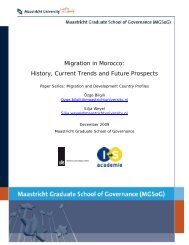Migration in Burundi: History, Current Trends and Future - MGSoG ...
Migration in Burundi: History, Current Trends and Future - MGSoG ...
Migration in Burundi: History, Current Trends and Future - MGSoG ...
Create successful ePaper yourself
Turn your PDF publications into a flip-book with our unique Google optimized e-Paper software.
Table 4 shows, the 1993 war, which lasted for 9 years, had the largest impact on<br />
<strong>Burundi</strong>’s population <strong>in</strong> terms of deaths <strong>and</strong> refugees. It resulted <strong>in</strong> over 300,000<br />
casualties <strong>and</strong> the displacement of 1.2 million people (Ngaruku & Nkurunziza, 2005;<br />
World Bank, 2009a). It affected not just certa<strong>in</strong> prov<strong>in</strong>ces but the whole country, <strong>and</strong> it<br />
destroyed <strong>Burundi</strong>’s economic, political, <strong>and</strong> social <strong>in</strong>frastructure. The civil war ended<br />
officially <strong>in</strong> 2005, when Pierre Nkurunziza became the new <strong>Burundi</strong>an president.<br />
In 1972 around 100,000 people died <strong>in</strong> what Lemarch<strong>and</strong> (1996) calls: “one of<br />
the most appall<strong>in</strong>g human rights violations <strong>in</strong> the annals of post <strong>in</strong>dependence Africa” (p.<br />
xxv). Genocide broke out <strong>in</strong> <strong>Burundi</strong>--the first of two <strong>in</strong> the period after 1962— <strong>in</strong> which<br />
the Tutsi Army killed primarily Hutus. As can be seen <strong>in</strong> Table 4, Ngaruku <strong>and</strong><br />
Nkurunziza (2005) estimate the total number of casualties of <strong>Burundi</strong>’s 1972 Genocide at<br />
200,000. Government groups were responsible for the deaths of almost 20,000 people <strong>in</strong><br />
Northern <strong>Burundi</strong> <strong>in</strong> 1988 <strong>and</strong> almost 3,000 <strong>in</strong> 1991 (Lemarch<strong>and</strong>, 1996). Aga<strong>in</strong>, as can<br />
be derived from Table 4, the estimates vary. The majority of casualties were of Hutu<br />
orig<strong>in</strong>.<br />
Table 4: Key Characteristics of Civil War <strong>in</strong> <strong>Burundi</strong><br />
Characteristic 1965 1972 1988 1991 1993<br />
Duration (months) 2 4 2 1 108<br />
Deaths (thous<strong>and</strong>s) 5 200 15 1-3 300<br />
Refugees (thous<strong>and</strong>s) 0 300 50 38 687<br />
Ratio of deaths plus<br />
refugees over total<br />
population (percent)<br />
0.2 14.0 1.3 0.7 17.1<br />
Years from previous war - 6 16 3 2<br />
Prov<strong>in</strong>ces affected Muramvya<br />
Whole<br />
country<br />
Ngozi,<br />
Kirundo<br />
Cibitoke,<br />
Bubanza,<br />
Bujumbura<br />
Whole<br />
country<br />
Source: Ngaruku & Nkurunziza, 2005.<br />
The root causes of conflict <strong>in</strong> <strong>Burundi</strong> are complex, debated, <strong>and</strong> strongly <strong>in</strong>tertw<strong>in</strong>ed<br />
with regional <strong>and</strong> historical issues <strong>in</strong> the Central African Great Lakes Region. Conflicts<br />
often spread to neighbour<strong>in</strong>g countries due to overlapp<strong>in</strong>g cultural identities <strong>in</strong> both<br />
countries, which has resulted, for example, <strong>in</strong> support from people from the same ethnic<br />
group across borders (Lemarch<strong>and</strong>, 2006; Spaan & Van Moppes, 2006). Lemarch<strong>and</strong><br />
(1997) describes the process as follows: “Where ethnic fault-l<strong>in</strong>es cut across national<br />
boundaries conflict tends to spill over from one area to the next, transform<strong>in</strong>g k<strong>in</strong><br />
solidarities <strong>in</strong>to a powerful vector of transnational violence” (p. 178)<br />
17



